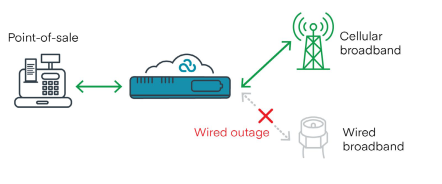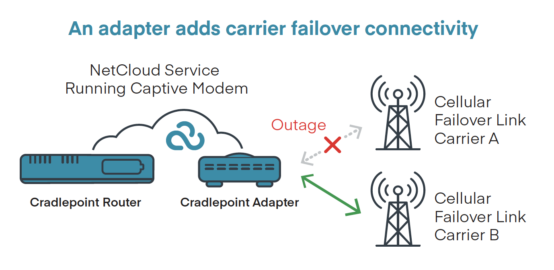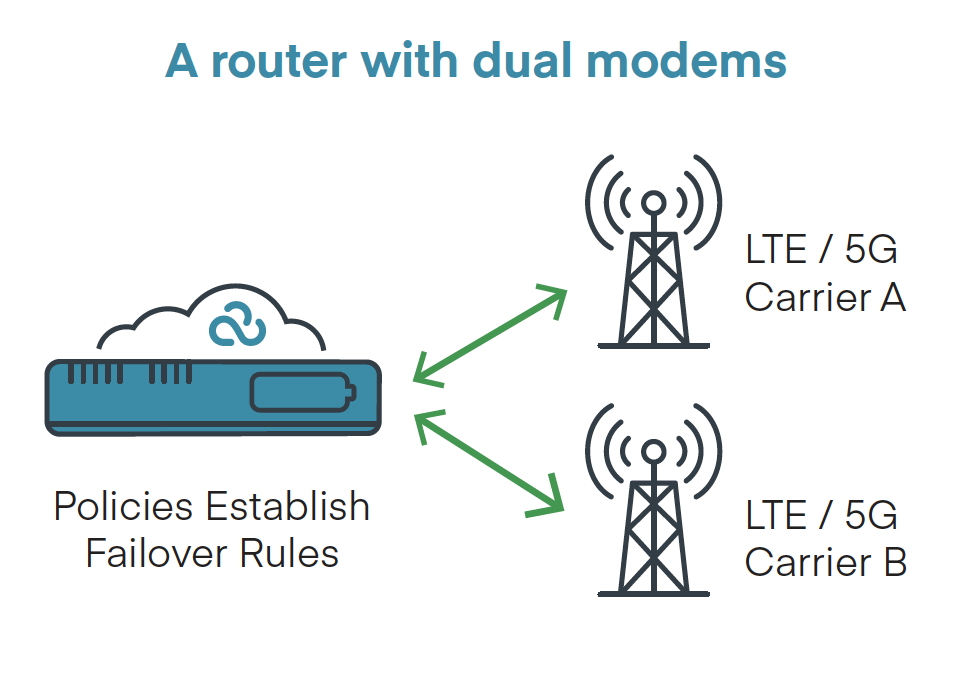Organizations are rarely able to continue their operations unimpeded when their primary wide-area network (WAN) connection goes down. Most businesses now run their workloads from the cloud, and employees use an increasing number of cloud-based applications to collaborate with other workers, process payments, and share files.
Increasing the diversity of your network’s components and connections is an effective way to reduce the single points of failure that can directly impact your operations. In particular, 4G Long-Term Evolution (LTE) and 5G technologies enable wireless WANs that are flexible while remaining cost-effective for maintaining branch, mobile, and Internet of Things (IoT) operations. The benefits include improved application performance, business continuity, and network uptime, especially when combined with software-defined WANs (SD-WANs). Using a few basic strategies, a hybrid of wired and wireless WAN links helps mitigate many risk points in a critical network.
This post on cellular router failover strategies is the first in a two-part series and will cover link diversity, dual-carrier connections, and hardware redundancy.
Utilize Link Redundancy
A WAN typically relies on a single wire to connects the branch or corporate network to the Internet Service Provider (ISP), who provides access to the Internet. Various events can disable this link, including severe weather, construction mishaps, a power outage, and configuration errors. Adding a secondary backup cellular WAN connection increases the network’s diversity and is an effective means of keeping communication alive when the primary WAN, say your ISP modem, is disconnected. While the second link is still susceptible to the same risks as the first, a single event is less likely to take down both connections simultaneously. Routers with rapid failover capability can seamlessly switch between a wired and wireless link, minimizing the network’s service disruption.

The best way to add a wireless WAN backup connection to an existing network is with an LTE or 5G router. It will provide the failover capabilities and include advanced management needed for configuring multiple WAN links. They have standard Ethernet and Wi-Fi interfaces that allow you to connect them to an existing network. You can often configure a router to scale with the size of your operation. High-end cellular routers usually include quality of service (QoS), routing, cloud management, and security features compatible with your infrastructure. Some enterprise-level routers support two independent LTE or 5G modems, providing primary and secondary wireless WANs with automatic failover without the trouble of physical cabling.
It’s possible to eliminate the typical ISP modem entirely. A dual, wireless WAN configuration consists of two LTE connections – one with low bandwidth and another with high bandwidth traffic. This design allows the low-bandwidth link to carry the most critical traffic, as defined by the router’s traffic management policies. A Gigabit 5G connection can provide the high-bandwidth link and permit the organization’s IT department to remotely monitor and troubleshoot the network.
Consider Additional Carrier Redundancy

A single wireless ISP or telecom carrier represents another risk point for maintaining the continuity of your network. Common failures for this architecture include domain name server (DNS) routing issues, network congestion, poor signal coverage, and a complete outage. You can reduce the risk of a carrier disruption and increase reliability by obtaining service from two wireless carriers, such as Verizon, AT&T, and T-Mobile. With separate infrastructures, it’s improbable that two carriers will be out of service at the same time. Wireless links increase the agility of mobile and pop-up retail businesses because the hardware is easy to move to a new location. Without the burden of a physical wire to the Internet, wireless routing becomes vital with this scenario.
The simplest way to implement multiple carriers is to use an LTE or 5G router that supports dual SIM cards. High-end routers often have this feature. Two SIM cards with active data plans are needed for each WAN router deployed on the network. This method imposes the additional cost of a second data plan and time to negotiate and maintain contracts with more than one carrier.
After the router and data plans are established, you manage the WAN links by setting routing policies that provide a seamless failover during zero or peak traffic periods. You can use one link as the primary and the other as a backup, or you can use them in combination to increase overall bandwidth. By specifying the path for each application and device, the router will send traffic to the carriers independently, improving performance and security.
Add Hardware Redundancies
Networks can also experience hardware failures caused by configuration errors, incompatible firmware updates, and failed cabling and connectors. Solving these problems often involves a site visit, leaving the network isolated for an extended period. Many organizations rely on continuous operations. That may require duplicated, or redundant hardware such as mirrored routers, where one router is the primary and the other is the backup.

If the primary router fails, the backup router takes over automatically until the primary router is restored. This configuration also allows you to perform scheduled maintenance such as updates and configuration changes without disrupting critical communications. It’s essential to set up policies to prioritize essential traffic if the backup router has less bandwidth. Both routers should have the same firewall features to ensure the backup router doesn’t introduce a security risk.
You can connect mirrored routers directly or through a managed Ethernet switch, with configuration parameters that identify the primary and backup. Additional options can also describe the conditions and timing that determine when a WAN link has failed. The routers should also share a Dynamic Host Configuration Protocol (DHCP) table and virtual gateway address to prevent disruption to other network devices. A router with Virtual Router Redundancy Protocol (VRRP) can help coordinate the failover. Because the network’s critical elements are duplicated, this method’s cost is much higher than the other strategies mentioned so far.
Summary
Our next post on cellular router failover strategies will continue with a discussion on intra-company connections, traffic spikes, and troubleshooting networks remotely. Read Part 2 of Cellular Router Failover Strategies: A Life Jacket for Your Network.

Leave a Reply